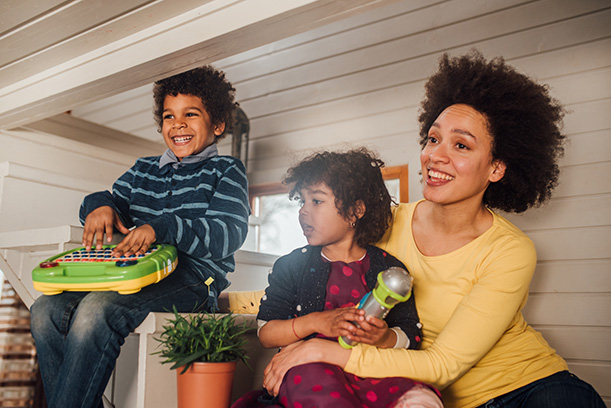BOOMbox at Home: Sound Activities
April 23, 2020

We found some simple experiments using everyday home items to really amplify your exploration of sound.
What Is Sound?
Sound is a type of energy made by vibrations. When any object vibrates, like the top of a drum, air particles move and bump into each other, and that causes vibrations and even more bumping among air particles. This movement by the air particles is called sound waves and keeps going until all the energy is used up. If your ears are in range, you can hear the vibrations. This is sound as we know it.
Try this. Place your open hand over the front of your neck, close to your voice box in your throat. Make a sound, any sound, like singing “la la la la” or even humming. Do you feel the vibrations? What happens when you change pitch, making your sound higher or lower?
Sound is influenced by many factors that can amplify, or make the sound bigger, or dampen, to make the sound smaller. Here’s a video from House of Sound that helps explain these concepts.
Rainsticks
Rainsticks are fun and simple instruments you can make at home that create a calming sound. They were first used by Native Americans to ask the gods to bring rain during spring or drought. Rainsticks are traditionally made from dried cactus stems or even stems of bamboo. When the rainstick is tipped over from one side to the next, it mimics the sound of gentle rain.
To make a rainstick, you need a cardboard tube, like an empty paper towel or toilet paper roll. You also need some things to mimic the sound of rain, like beans, rice, or macaroni noodles.
Cover one end of the cardboard tube with tape and, if you have thumbtacks handy, stick them in along the tube. They act as stoppers to make the rain sound more natural when the tube is tipped. Now add your mixture of rice, beans, or noodles with a funnel and close off the open end of the tube with tape.
Be as creative as you like by decorating your rainstick with adornments like construction paper or string.
For more information on rainsticks, see the following links and video tutorials:
NASA Climate Kids: Rainsticks and Folklore
See Sound
Teach younger kids the basics of sound with these simple sound science projects using kitchen basics and other materials you likely already have at home. These experiments are great for visual learners, because you can see the vibrations of sound in real life.
Make Music
Try making a track with some free music production software. If you aren’t sure where to start, you can find tutorials on the Lynda.com Online Learning Library. See our online training tutorials to learn how you can log in with your library card.
Share
We’d love to see the results of your experiments! Tag @skokielibrary when you share photos of what you’ve created on social media.
This week's post was written with Eli and Mahnoor.